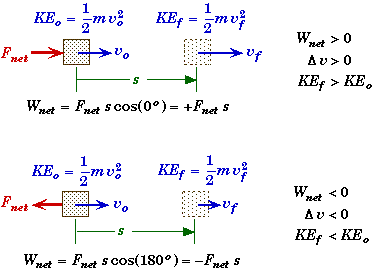Work-energy theorem: Difference between revisions
J.williams (talk | contribs) No edit summary |
J.williams (talk | contribs) m (1 revision imported) |
(No difference)
| |
Revision as of 21:31, 26 August 2015
The work-energy theorem explains the idea that the net work (total work done by all the forces combined) done on an object is equal to the change in the kinetic energy of the object. After the net force is removed (no more work is being done) the object's total energy is altered. This is expressed by the equation:[1]
.
is the total work done.
is the change in kinetic energy.
is the final kinetic energy.
is the initial kinetic energy.

An example
Take for example a skier moving at a constant velocity on a flat frictionless surface. If his friend comes behind him and pushes him for some distance (in other words, does work on him), then the skier will speed up (his kinetic energy will increase). This is known as positive work, as the force was applied in the motion of the skier. If however the friend pushed opposite to the skiers motion, the skier would slow down (his kinetic energy would decrease), and this is known as negative work. (The visual to the right is an example of such a situation, just with the skier replaced by a block).
Since in reality there are no frictionless surfaces, the friction force opposing the skiers motion would have to be accounted for and this is why the equation contains the term Wnet, as it is a sum of all the forces acting over a distance.

